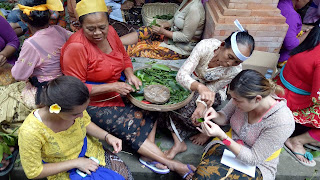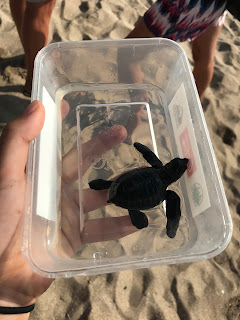 |
| Me and my Ulu-crew |
As our little Fokker-100 flew into Alice Springs airport, Nolan and I noticed red sands, patchy grasses, and utes speeding along straight roads. We met Gianna, who was equally excited to be in a less Americanized version of Australia. The three of us enjoyed our first Outback sunset on top of Anzac Hill before getting Indian food for dinner. I was annoyed that I had to pay an additional $4 for rice on top of an already expensive meal, but Nolan reminded me how difficult it is to transport goods to the middle of the country. That night in the hostel, I didn't sleep well. I hadn’t slept well in the nights leading up to the trip because of coughing, but this time I couldn’t sleep because I was incredibly excited to start this adventure. I woke up twice that night to check the clock and make sure that we hadn’t missed our pick-up.
 |
| I was "keen" to be in the Outback with my Keens. |
We were picked up from our Alice Springs hostel at 6 AM in a pink van by a guy named Scruffy from Mulgas Adventures. Scruffy had long, curly hair and always wore a beanie, reflective sunglasses and a cut-off tee shirt. He looked like he was quite a character, and he was. According to Scruffy, you haven't really been for a country if you've been there for less than 4 months. By his definition of travel, he has been to 30 countries. By my definition, he's been to 57. He has also been deported from 2 different countries. He was kicked out of Thailand for stealing a gibbon from a guy who was abusing it, and a corrupt police officer threatened to put him in jail for 10 years. Scruffy was an expert on local Aboriginal cultures, rock formations, flora and fauna, and life in the outback.
I mostly slept during the 5 hour journey from Alice Springs to our campsite. We stopped a couple times to use the toilets and refuel. We also stopped at a camel farm where I got to ride a camel named Curly!
When we finally arrived at our campsite, I learned a new definition of the word "swag." Swags are like a combination of a canvas tent and a sleeping bag with a mattress inside. Surprisingly, they were very comfortable and I actually preferred it over sleeping in a tent because it gave us a great view of the stars!
 |
| Here's our group packing up our swags at the campsite |
We ate lunch and introduced ourselves to the rest of the people on our tour. There were people on our tour from Italy, Germany, Austria, Japan, Brazil, Australia, Ireland, and Canada! In addition to having 5 of 7 continents represented, we had people of all ages as well. The first people we met were Keith and Denise, a 68-year-old couple from the Sunshine Coast. They told us how they had been wanting to see Uluru, and felt like now was the perfect chance. They had no idea that they had booked a backpackers' trip, but they kept up with the group during hikes and didn't have trouble camping outside. We also met a group of girlfriends, named Claire, Chiara, and Liz from Sydney. They are all in their mid-20's, established in jobs, and dating. I loved the fact that they were all traveling together. I had always wanted a similar group of friends who were committed to exploring the world with me; I felt blessed to be with Nolan and Gianna because I feel like they are becoming those people for me. We also met a cute middle-aged couple named John and Sarah. I liked them because you could clearly tell how much they loved each other despite the fact that they were always harassing each other. I also met a girl my age from Italy who was working as an au pair, a German couple on their honeymoon, and a group of friends from Brazil. The awesome people I met definitely added to an amazing weekend.
Uluru
We wasted no time before heading to Uluru. As we drove up and I saw it for the first time, I was amazed. I couldn't imagine what it would have been like as a nomadic Aboriginal or a white colonizer exploring Australia’s harsh inland and walking up to the immense rock in the middle of the outback.
The rock itself is amazing. It is the second largest monolith in the world. Nolan and I argued about whether or not it was an igneous or metamorphic rock, but we nerds were both wrong because it's sedimentary. It appears to be a stunning red color during the day when the sun hits it, but changes to purple and grey as the light changes. It is actually a grey color (which you can see in the caves) which has turned red as a result of the iron in the sandstone oxidizing. Up close, the surface of Uluru appears to be flaking off. Something else that surprised me was that Uluru is a semi-permanent waterhole. The area had just experienced a lot of rain just before we arrived, so there was plenty of water when we got there!
No wonder Uluru is a spiritual location for the Anangu people. For the Anangu people, Uluru is essential to Tjukurpa, which is their understanding of creation and the laws of life. Each face of the rock has identifiable marks that are explained with stories. For example, a line on the face of Uluru represents a python woman who fights an evil snake man who kills her nephew. These stories not only explain the history of the natural surroundings, but are also used as lessons. Each story has multiple layers, each with 3 lessons. Children are taught each layer of the story when the elders determine that they are ready. Patience is critical in Aboriginal societies. In order to become an elder in the community, one must know all of the stories and the lessons.
The land around Uluru provides resources, including water which attracts animals which become food. It was a beautiful place for the Anangu people and the white men who "discovered" it and renamed it as Ayers Rock. The rock has since been returned to the Anangu people, but this land is shared for the National Park which is led by a counsel of 12 people (4 Aboriginal male elders, 4 Aboriginal female elders, and 4 white people). They have to make decisions about the National Park, including the controversial decision about the climb. Aboriginal culture forbids the climbing of Uluru because it is a sacred site, however there is a chain along the side of the rock to assist people in climbing the mountain. Plenty of people have died during this climb, and plenty more have been injured. Many of the rangers who have to rescue the people who are injured during the climb are Aboriginal, which puts them in a difficult situation when choosing between respect for their religion and their duty as a ranger. Thankfully, there are a lot of reasons that this climb can be closed, as it was when we were there. There is hope that if fewer than 20 percent of visitors to the park choose to climb Uluru, the climb will be closed for good.
 |
| The irony - a sign that says that you can't climb Uluru next to a sign that gives you the option to climb Uluru |
We drove a few kilometers from Uluru to get a good view of the rock during sunset. This was the first time that I was focused on a rock, rather than the actual sun, during the sunset. It was amazing to see the rock change color, from red to purple, as the sun set.
Kata Tjuta
The next morning, we were woken up at 4 AM to see the sunrise at Kata Tjuta. The words "Kata Tjuta" means "many heads" as the dome-shaped rock formations resemble heads. The sunrise was pretty spectacular, as was the rest of the hike! Similar to Uluru, Kata Tjuta is also a sacred site. Ceremonies are still conducted there today, although the location is far from the hiking path and a secret from tourists.
After we left Kata Tjuta, we returned to our campsite for lunch. We had camel burgers. They tasted really good, but at first, they didn't sit well with my stomach. I learned that in Aboriginal culture, you get sick when you eat your spirit animal. I was thinking that camel was my spirit animal, but I digested before we hopped back into our van.
Once again, I fell asleep again on the way to our next campsite. I woke up to the sound of wheels turning fruitlessly in the dirt. We stopped to collect firewood and got stuck in the process. While I felt like it was the worst possible thing to wake up to, I could see in Nolan's face that he was secretly excited. After collecting the wood we needed, we dug out our tire and began to push. I thought it was ironic that this was the second country I had traveled to where I had to do this, but thankfully have never had to do it at home. However, unlike in Haiti, the girls had to help push too.
Fortunately, we were able to get back on the road in one piece. We stopped once more to refuel when Scruffy asked if anyone was interested in going up in a helicopter. Initially, I dismissed the idea because I thought it would be expensive. But when Scruffy told us that it was only $60 to go up for 5 minutes, Gianna, Nolan and I looked at each other expectantly. Next thing you know, I was ooh-ing and ahh-ing into my helicopter headset and spotting goanas from the air. It was a very impulse decision, but I was happy to simultaneously add something and check something off my bucket list.
Our next campsite had an even better view of the stars (somehow), a fire pit, and a very cold pool. We also saw brumbies (wild horses) walking through the bush under the setting sun. I really enjoyed toasting marshmallows and talking to the other people in the group about their homes, their travels, and their stories.
King's Canyon
The next day, we left for King's Canyon at 5:15 AM (we got to sleep in a bit that day). The first thing we did was climb "heart attack hill." Somehow, I think King's Canyon was more beautiful than Uluru and Kata Tjuta combined. We walked a total of 7 kilometers as Scruffy told us about the native plants and this history of the rock formations.
After returning to the campsite for a quick dip in the pool and some lunch, it was time for us to say goodbye. Some of the group stayed for another day, but we had to return to make our flight in the morning. We were sad to leave the Outback and the new friends that we made on the tour – they chased the bus as we pulled away! Camping is not usually my thing, but this was my favorite trip that I have done in Australia so far! I learned about Aboriginal culture, I made experienced nature in an un-touched region of Australia, and I made friends with people from other countries! Camping in the Outback with Mulgas Adventures was the best possible way to experience the outback!
 |
| The pink bus and our friends from the tour - chasing the bus as we pulled away |















